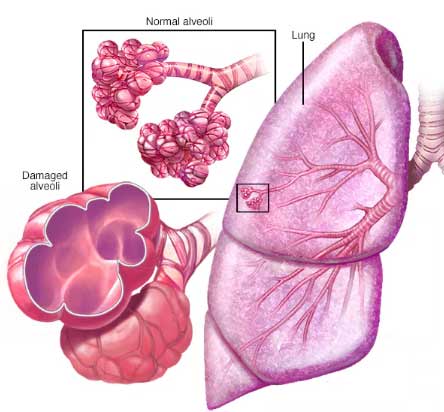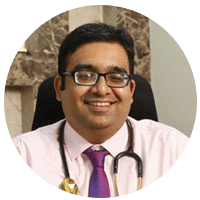Copd Doctor in Mumbai
Chronic Obstructive Pulmonary Disease
Chronic Obstructive Pulmonary Disease (COPD) is a preventable and treatable lung disease. People with COPD must work harder to breathe, which can lead to shortness of breath and/or feeling tired. Early in the disease, people with COPD may feel short of breath when they exercise. As the disease progresses, it can be hard to breathe out (exhale) or even breathe in (inhale).
A person with COPD may have obstructive bronchiolitis, emphysema, or a combination of both conditions. The amount of each of these conditions differs from person to person.
Asthma is another disease that causes narrowing of the airways, making it hard to breathe at times, but asthma is not included in the definition of COPD. Some people do have a mix of both COPD and asthma.

What is Obstructive Bronchiolitis?
Obstructive bronchiolitis is a condition in which chronic inflammation and swelling cause the inside of the breathing tubes (airways) to be smaller than normal. This narrowing interferes with how well and how easily air empties out of the lungs (expiration).
What is emphysema?
The lungs are made up of more than 300 million tiny air sacs called alveoli. These air sacs are normally stretchy and springy. When you breathe in, the air sacs expand like tiny balloons. Breathing out usually is passive (takes no effort) as the alveoli “spring” back to their original size. In emphysema, the walls of the air sacs (alveoli) of the lung are damaged and lose their stretchiness. As a result, they do not empty easily. Emphysema can also contribute to the narrowing of the airways.
The combination of non-stretchy alveoli due to emphysema and narrowed airways due to both obstructive bronchiolitis and emphysema prevents the lungs from emptying normally. This causes air to become trapped in the lungs. “Air trapping” or the inability to fully exhale, leads to abnormal expansion or hyperinflation (hi-per-in-flay-shun) of the lungs. Constantly having trapped air in the lungs combined with the extra effort needed to breathe results in a person feeling short of breath.

What causes COPD?
Although the most common cause of COPD is tobacco smoke, there are several other factors that can cause or make COPD worse, including environmental exposures and genetic (inherited) risk. For example, heavy exposure to certain dust at work, chemicals, and indoor or outdoor air pollution (including wood smoke or biomass fuels) can contribute to COPD.
How do I know if I have COPD?
Common signs and symptoms of COPD:
- Shortness of breath, also called “dyspnea,” while doing everyday activities
- Constant coughing or wheezing sometimes called a “smoker’s cough”
- Chest tightness or inability to take a deep breath
- Recurring respiratory infections
Loss of energy - A blue hue around the lips and fingernail beds called “cyanosis”
- Unintended weight loss
If you have these symptoms, you should talk to your healthcare provider. Some people with early COPD may not be aware of symptoms.
Testing should be done in people who are at risk for COPD. Your healthcare provider may have you do a breathing test (lung function test) called spirometry. Spirometry measures your ability to exhale and can detect whether your airways are narrowed.
How does a healthcare provider know a person has COPD?
Healthcare providers diagnose COPD based upon the combination of symptoms and test results. The single most important test to determine if a person has COPD is spirometry. Changes of COPD can also be seen on a chest x-ray or a chest CT scan. Once your healthcare provider has determined that you have COPD, he or she may order other tests to assess how well you are breathing with sleep and with exercise (six-minute walk test). This includes looking at your oxygen saturation levels (Arterial blood gas analysis).
How is COPD treated?
- The first and most important treatment of COPD in smokers is to stop smoking. Medications and other therapies are available to help treat nicotine addiction and to help you stop smoking.
- Medications can also be prescribed to help relieve symptoms of COPD and to prevent symptom flares (called exacerbations) that can lead to further loss of lung function. Some general classes of medications include those that aim to widen the airways (bronchodilators), reduce swelling in the airways (anti-inflammatory drugs, such as steroids), and/or treat infections (antibiotics). Other than antibiotics, most COPD medications should be taken every day, usually for life.
- Avoid contact with those who are sick, wash hands often, get a yearly flu vaccine, and get a pneumonia vaccine when recommended by your healthcare provider.
- In some people, COPD can also cause the oxygen level in the blood below. If this occurs, a person can be given supplemental oxygen.
- Proper nutrition and staying in good physical shape are also important not just for symptom relief but also for your quality of life.
- Pulmonary rehabilitation programs offer supervised exercise and education for those with breathing problems and should be a part of a comprehensive treatment plan for anyone with COPD.
- In some cases, surgical procedures such as lung volume reduction surgery or lung transplantation may be options to consider.
- If you have COPD, it’s important to make sure that other diseases you may have, such as high blood pressure, heart disease, diabetes, and asthma, also are being treated.
Will COPD ever go away?
The term chronic, in chronic obstructive pulmonary disease, means that it lasts for a long time. Symptoms of COPD sometimes improve when a person stops smoking, takes medication regularly, and/or attends pulmonary rehabilitation.
However, the lungs are still damaged and can never fully return to normal. Therefore, COPD is a lifelong condition. Breathlessness and fatigue may never go away entirely, but people can learn to manage their condition and continue to lead a fulfilling life.

Dr. Parthiv Shah
Best Pulmonologist in Mumbai
